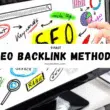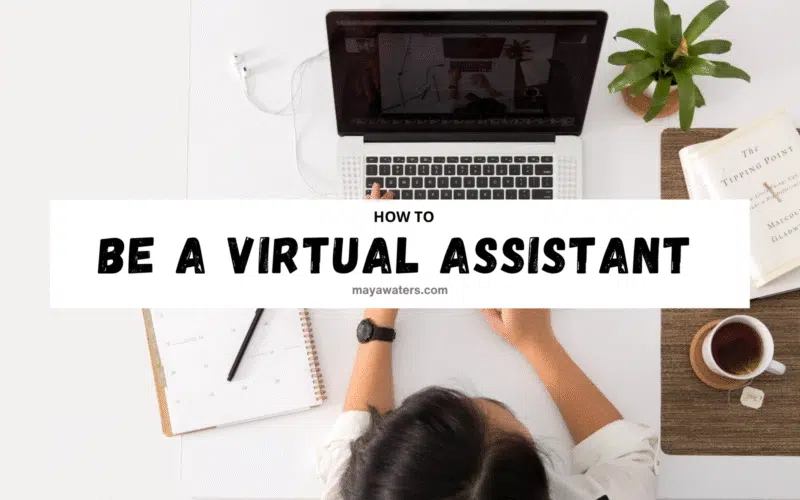This is your mini-course on how to become a virtual assistant — because you can do this, even if you don’t feel qualified and your “home office” is literally the corner of your kitchen table. Don’t worry, I’ve been there. Let’s turn that spot into your money-making HQ.
If you’re trying to figure out how to become a virtual assistant, start with no experience, and actually make money doing it — you’re exactly where you need to be.
We’re going full Maya Waters here: easy steps, real talk, fun, beginner-friendly, and totes doable. 😉
What Even Is a Virtual Assistant?
A virtual assistant (or VA) is someone who helps businesses and entrepreneurs from home (or Starbucks if you’re like me and need the vibe + Wi-Fi).
You might do things like:
- Email management
- Scheduling
- Social media help
- Customer service
- Data entry
- Content formatting
- Research
- Pinterest management
- Blog updates
- Light bookkeeping
- Inbox cleanup (which makes you a literal hero)
Think of it as being an assistant… but online. No traffic, no office fridge thieves, no HR dress code meetings.
The Real Reason Becoming a Virtual Assistant is So Popular
Companies love virtual assistants because:
- They don’t have to hire full-time staff
- They can tap into global talent
- It’s cheaper than in-house employees
- They only pay for the hours/work they need
And VAs love it because:
- You pick your schedule
- You pick your clients
- You can work from anywhere
- You can scale your income
- You don’t need a degree or certification
People do this full-time, part-time, or on the side while watching Netflix and eating chips. No shame.
Day 1: Figuring Out Your Virtual Assistant Type
There are two main types:
1️⃣ General Virtual Assistant (The Variety Pack)
Helps with a little bit of everything. Perfect if you’re just starting and don’t know what to specialize in yet.
2️⃣ Specialized Virtual Assistant (The Expert)
Focuses on one specific thing like:
- Pinterest VA
- Social media manager
- Podcast assistant
- Real estate VA
- Email marketing VA
- Bookkeeping VA
General VAs earns around $20–30/hr to start. Specialized VAs can earn $50–100/hr+.
That’s why niching down is a long-term glow-up… but you do NOT have to start specialized.
Skill Assessment: What Can You Offer?
Grab a pen, phone notes, or the side of an Amazon box — and list:
1️⃣ Hard Skills
Graphic design, data entry, Canva, Shopify, Google Sheets, writing, editing
2️⃣ Soft Skills
Organizing, communication, problem solving, being calm when the client is… not
Now cross off anything that can’t be done remotely and anything you hate doing.
Tip: Just because you can answer phones doesn’t mean you should.

Day 2: What Should You Offer (and What Should You NOT Offer)?
Long story short — offer what you’re good at + enjoy + people are already paying for.
Examples of in-demand VA services:
☑️ Pinterest management
☑️ Inbox cleanups
☑️ Blog formatting
☑️ Customer support
☑️ Travel planning
☑️ Social scheduling
☑️ Short-form video editing
☑️ Shopify order management
☑️ Calendar organization
Services you can say NO to:
- Cold calling
- Sales
- Creepy tasks (if someone says “need help pretending to be me online” — no thank you)
- Anything against your ethics or sanity
Setting boundaries makes the right clients respect you and the wrong clients run away — which is a win.
Day 3: How to Price Your Virtual Assistant Services
This is where most beginners panic. Stay with me.
Things that affect your rates:
- Where you live
- Your skills
- Demand for your services
- Experience level
- How specialized you are
Typical VA pricing:
- Beginners: $20–25/hr
- Intermediate: $30–45/hr
- Specialized: $50–100/hr+
Eventually, you’ll want to move into packages instead of hourly.
Example:
“I’ll manage your inbox + calendar + weekly client follow-ups for $600/month.”
Packages = predictable income + better boundaries + less time watching the clock.
Day 4: How to Find Virtual Assistant Clients
This is the #1 question: “Where do I actually find clients?”
Here’s the cheat sheet:
Beginner-friendly places to land your first VA client:
☑️ Facebook groups
☑️ Twitter/X
☑️ Upwork
☑️ Fiverr (but don’t stay there forever)
☑️ Freelance job boards
☑️ Referrals
More advanced client sources:
- Cold email
- Niche networking communities
- Podcasts
- TikTok/YouTube content
- Pinterest traffic to your site
Find your clients where THEY hang out.
If your dream client is a real estate agent, they’re not chilling on Pinterest—they’re on Facebook or LinkedIn.
The Virtual Assistant Side Hustle Breakdown
Step 1 : Pick your service(s)
Step 2 : Create a simple brand name & email
Step 3 : Set up a basic portfolio (Canva, Google Doc, or simple website)
Step 4 : Create a rate sheet or starter package
Step 5 : Start pitching and applying
Step 5 : Land first client and get testimonials
Step 6 : Raise rates, refine niche, build waitlist

Becoming a virtual assistant isn’t about luck. It’s about choosing a profitable service, offering it well, and putting yourself in front of the right people online.
Working as a VA can be a beginner-friendly way to escape a job you hate, earn money while staying home with your kids, or kickstart your online career.
If you’re fired up about how to become a virtual assistant and you actually want to start making money with it instead of just thinking about it, then do yourself a favor and download my Free Virtual Assistant Workbook below, to go with this mini course.
It helps you map out your skills, build your confidence, and get client-ready — no email, no sign-up form, no “I promise I won’t spam you” fine print. Lol.
Just click, download, and goooo!
And listen… I’ve gotta say this, because nobody else does:
Most bloggers don’t give away anything unless they’re getting something back — usually your email address. And emails are valuable. That’s why if you ever choose to give me yours, it’ll be because I earned it.
But a “freebie” that costs you your email? That’s not a freebie. That’s a trade. So, here’s an actual freebie. No catch. No forms. No inbox clutter.
Just a helpful workbook from me to you — because you deserve the real thing.
Your broke girl era? It ends here.
Now go build your business, boss babe.
If you want to work for a virtual assistant agency before starting your own VA business, that’s actually a smart move — especially if you’re brand new. Joining an agency lets you get your feet wet, try real client work, and see if being a virtual assistant is something you enjoy before going all-in.
Think of it like a test drive. You’ll get experience, build confidence, and decide whether you’d rather run your own VA business someday or stick with working for someone else. Either way, starting with an agency is a great way to learn the ropes without having to figure everything out alone.
Check out this virtual assistant agency list .
How to Become a Virtual Assistant FAQ
How do I become a virtual assistant with no experience?
Start with general services like inbox management, research, or data entry. Offer your services to friends, small businesses, or through job boards. No degree required.
How much can a virtual assistant make?
Beginners typically make $20–30/hr, but specialized virtual assistants can earn $50–100/hr or more depending on skillset and niche.
Do I need a certification?
Nope. Certifications can be helpful but are not a requirement to get clients. Experience + confidence matters more.
Where do virtual assistants find work?
Facebook groups, LinkedIn, freelance sites, job boards, referrals, and through your own marketing.
Can I be a VA part-time while working a job?
Absolutely. Most people start that way.
Is It Too Late to Become a Virtual Assistant in 2026?
Nope. Not even close. This industry is exploding.








